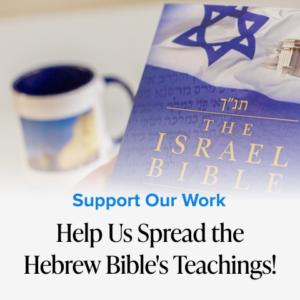The portion of Acharei Mot picks up following the deaths of Aaron’s older sons, Nadab and Abihu. It contains the instructions for the Yom Kippur — or Day of Atonement — service in the Tabernacle, and forbids slaughtering animal offerings outside the Tabernacle and the consumption of blood. It lists a series of forbidden relationships and other abominations condemned by God, and emphasizes the holiness of the Land of Israel.
The Yom Kippur Service
Our portion begins with the Yom Kippur service. God tells Moses to tell Aaron and his surviving sons that they are not to enter the Holy of Holies, separated from the rest of the Tabernacle by a curtain, except on the Day of Atonement. Dressed in his white linen garments, which he dons after immersing himself in water, the High Priest is to take a young bull as a sin offering and a ram as an elevation offering on his own behalf, and two goats as a sin offering and a ram as an elevation offering for the people.
First, the High Priest draws lots over the he-goats, selecting one for God and one for Azazel. The goat for God is sacrificed, while the goat for Azazel — the Scapegoat — is thrown off a cliff in the wilderness later in the service. He then brings his own sin offering, to atone for himself and his household. He prepares incense with which he enters the Holy of Holies, and there sprinkles blood upon the cover of the Ark of the Covenant. He also sprinkles blood upon the altar outside.
After the goat for Azazel is dispatched, the High Priest removes his linen garments and immerses himself again, putting on his other garments, and completes the two elevation offerings. The priest who dispatches the scapegoat and the one who removes the sin offerings for burning must immerse before re-entering the camp.
The laws of Yom Kippur for the nation are also included in this section. The day is commemorated on the tenth of the seventh month with fasting and purification.
Typically, the High Priest wears eight garments, four of which are resplendent with gold embellishments. On Yom Kippur, however, he performs the service in the Holy of Holies wearing only the four linen garments. As the Israel Bible explains, this helps him serve with humility. The white garments are the color of forgiveness, so they remind him and the people that all is in God’s hands.
Points to Ponder
Although there are three pilgrimage festivals, which require the entire nation to come up to Jerusalem and serve God in the Temple, Yom Kippur is not one of them. Why do you think God did not mandate the participation of the entire nation in the service of the Day of Atonement?
Offerings Outside the Tabernacle and Blood
Although God permits His people to eat meat, in this portion he instructs the people only to slaughter animals as peace offerings in the Tabernacle. Offerings brought outside the Tabernacle are considered bloodshed, and cause the person to be cut off from the nation. The Israel Bible explains the reasoning for this command. One purpose for the sacrificial service is the create unit among the nation. By mandating service be performed in the Tabernacle, and later, the Temple, God limits the possibility of variety of worship. LIkewise, He builds in an opportunity for all the Children of Israel to spiritually recharge three times annually by attending the pilgrimage festivals in Jerusalem.
Likewise, the Torah prohibits the people from eating the blood of the animal, as it contains the soul and serves as atonement for the sinner’s soul. Instead, the Torah instructs the people to pour out the blood of the animal and cover it with earth. This applies to wild animals which were trapped and slaughtered.
Finally, the Torah warns against eating a creature that died on its own or was torn apart by a beast. One who does must immerse himself and is contaminated until evening.
Points to Ponder
Why do you think slaughtering animals outside the Tabernacle would be considered bloodshed?
Abominations and the Holiness of the Land
This section begins with a command not to follow in the abominable ways of Egypt, from which God has taken the Children of Israel, or of Canaan, to which God is bringing them. Rather, they are to walk in God’s ways of holiness.
From there, the text elaborates on forbidden relationships. These include adultery, incest, bestiality, marrying two sisters, or lying with a woman in her time of separation. The Torah also forbids passing a child to Molech, which the Sages define in the Talmud as a specific form of idolatry.
All of these commands are instructed because the land will not tolerate contamination, and, God warns, if they fail, they will be cast out of the Promised Land just as the previous inhabitants were. In fact, the Israel Bible points out, the Children of Israel do ultimately commit the same grievous sins as their predecessors, and are, indeed, cast out of the land into exile. Today, the people of Israel have returned to the land, but the warnings in this chapter are as salient as ever.
Points to Ponder
Why might the prohibition on worshiping Molech be included in a chapter that details forbidden relationships?














